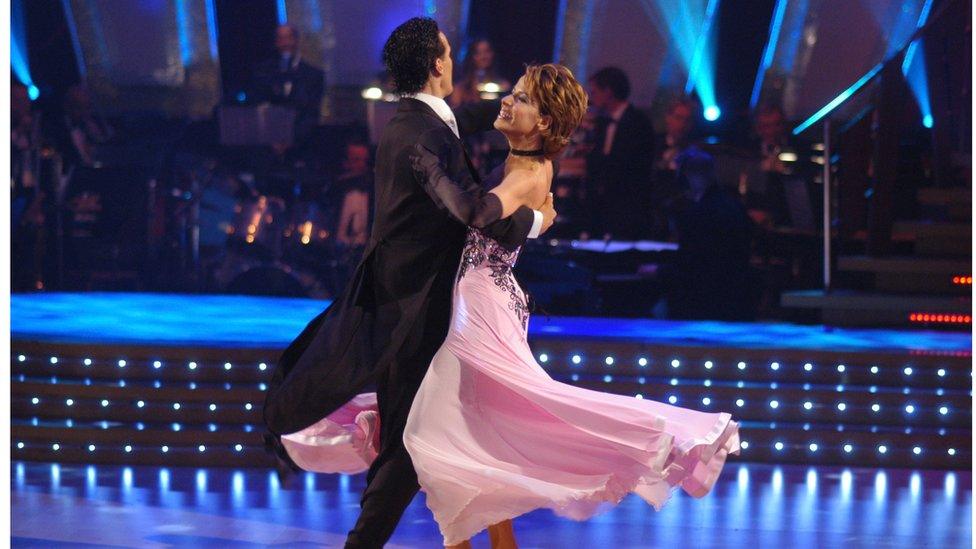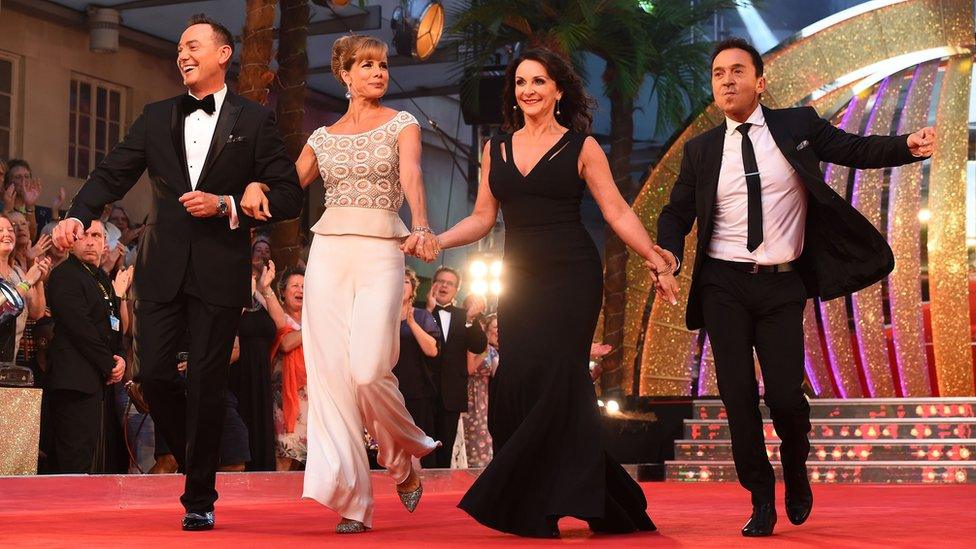Strictly Come Dancing: Can you predict the winner?
- Published
- comments
What can you tell from the scores of previous winners and losers?
The BBC's Reality Check team was wondering, after 14 series of Strictly Come Dancing, an extraordinary amount of fake tan and millions of sequins, what can numbers tell us about who might win?
We have taken the judges' scores for all the contestants every week for all 14 series of the programme, largely from the fan-site Ultimate Strictly, external, and looked at whether you can predict the outcome using statistics.
The Strictly team does not give out the results of the public vote, even to us, so we'll have to go on what the judges said and which couples were ejected from the competition each week.

The first series of Strictly, won by Natasha Kaplinsky and Brendan Cole, ran for only eight weeks
This is what we discovered.

Has there been points inflation?
At first glance it looks as if the number of points the couples get from the judges has been increasing, especially in the first six series.
In this chart, we've looked at the average number of points given by the judges in each series.
If you've really been concentrating, you'll know that in the 14 series there were a total of four weeks when they had five judges - we've adjusted for that.
But if you look further into the numbers, it turns out that there is a more important factor than points inflation.
The first series of Strictly ran for eight weeks with eight celebrities - series 14 had 15 couples and 13 weeks of competition.
It means that the finalists in the last series had almost twice as many programmes to hone their skills as the ones in the first - so no wonder they were getting 40s by the end, while the average score in the final in 2004 was 28.

Who is the toughest judge?
It will be no surprise to regular viewers of the show that the toughest judge to please is Craig.
On average, he is about a point tougher on contestants than the other judges are.
In the first 14 series, Craig Revel Horwood, Bruno Tonioli and Len Goodman served as three of the four judges, with occasional help from guest judges.

In series 15, Shirley Ballas is replacing Len Goodman as head judge
The fourth spot was taken by Arlene Philips for six series, Alesha Dixon for three and Darcey Bussell for five.
But while it is harder to impress Craig, if you get a 10 from him you are almost certain to make it to the last three in the competition.
It should be said though that he doesn't give 10s early in the competition.
Ali Bastian and Brian Fortuna in episode eight of series seven, and Danny Mac and Oti Mabuse in episode nine of series 14 were his earliest.

Does the dance make a difference?
There are all sorts of perceptions about easy and difficult dances, with some striking fear into the heart of competitors.

Ed and Katya actually got 26 points for their cha cha cha, their second highest score
Some dances do appear to be harder than others - but the effect is small.
Each of the samba, rumba, cha-cha-cha and jive has resulted in scores that were 1.5 points lower on average than for other dances (that is, 1.5 points out of 40), which is probably not enough to send a would-be winner to the dance-off.
And in case you were wondering, there is no significant impact from where you appear in the show - going first or last won't affect your chances.

Can you predict the winner?
Viewers may be pleased to hear that you can't predict the winner or the finalists completely reliably.
If you look at the situation half way through the competition, it is possible to make predictions of who the last three couples in the competition will be that were about 70% accurate for the 14 series so far.
The most important determinant at that stage is how many points the couples get from the judges that week.
Whether they have yet been involved in a dance-off makes surprisingly little difference.
There is evidence that the judges tend to give slightly higher scores to female celebrities, but it's not enough to influence who gets to the dance-off or indeed who wins the competition, which has been won eight times by men and six times by women.
And it's important to stress that it's still all to play for - if a couple reaches the half-way stage, then there is nothing they can have done so far that means they definitely won't get into the final.
But that's not to say there isn't a reliable indicator out there that we haven't tested. Could shoe size be the key indicator? Or the number of rhinestones on the costume? Or what the judges had for breakfast? Strictly-obsessed statisticians - we lay down the gauntlet to you.

With thanks to Susan Connolly from the MRC Biostatistics Unit at the University of Cambridge for help with the statistical analysis.



- Published22 August 2017
